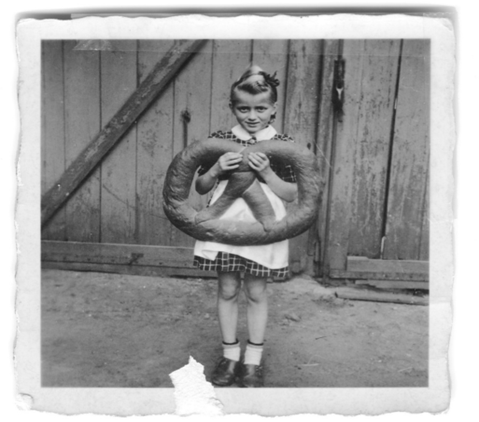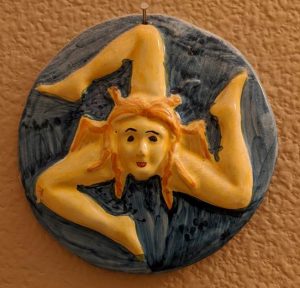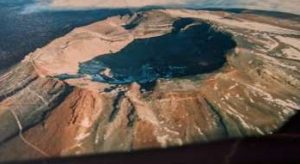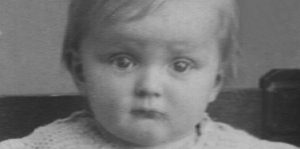It was with great satisfaction that I returned to Germany in 1991, the country of my birth, to teach business and management for UMUC on over 20 military sites. I had left Germany as a war orphan during the first years of the American occupation while Frankfurt was in bombed out rubble in the early 1950s.
It was a sweet homecoming to a now modern country – recently reunified. East and West Germany were one nation again. Change was everywhere – most visibly in the construction as road were repaired in the more neglected east. Germans were streaming in from the “Ostzone” for better jobs. Many were reuniting with relatives in the west while others went east to reclaim properties confiscated during the Soviet occupation. The Soviet Union collapsed later that year signaling the end of the Cold War
It was an exciting yet uncertain time. The U.S. military in Europe would be downsizing. Many military sites closed. Often, I was one of the last instructors to teach there including, Wiesbaden, Mainz, Munich, parts of Augsburg and Stuttgart, Aschaffenburg, Bitburg, etc. My one-year contracts gave me little certainty, but it worked out for me to stay and work in the European Division for the next six years
The first days of orientation at the UMUC Heidelberg headquarters were typical social welcoming events. The European Division included teaching sites expanded beyond Germany. Happily, my assignments would include Italy and Bahrain during my time there. Joe Arden, our director, and his team of area directors and staff let us newbies know they were there to support our mission so that our students had a productive learning experience. A good sign that my positive experience in the Asia Division was to continue and be global.
After the usual business of getting our military ID cards, we had to get a military driver’s license to drive on the German Autobahn. It was panic time amid jet lag for all of us. A few failed the test. Woe! The questions were complicated with lots of road signs to identify and to know. The strict guidelines for the German – Good Samaritan Law – was new to most of us. This law required us to keep a full first aid kit in our cars and stop for accidents and offer first aid if no one else was around to help. In the end, all made it through the tests and got the required military driver’s licenses to meet the challenges of the Autobahn.
We were busy with course distributions that included our designated teaching sites – I got three different military sites for my first eight- week session. We loaded up on textbooks and reams of general information about the area while enjoying great beer and bratwurst. Good feelings of camaraderie with my new colleagues and the happy discovery of the Italian ice cream shops selling deliciously addictive gelato set the stage for good times ahead. Sitting in the town square with colleagues and a stunning view of the famous Heidelberg castle made a memorable beginning for my teaching in the European Division.
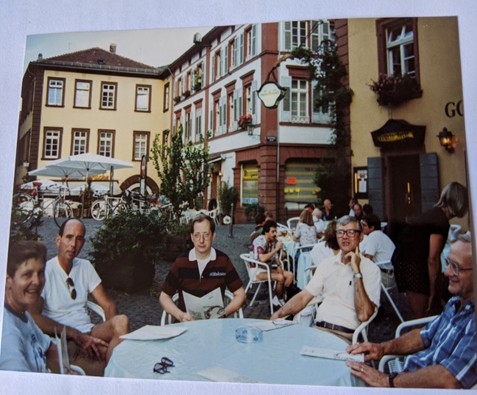
In memory of my graduate studies on Max Weber, I took the grand hike along the winding Philosophen Weg – across the river Neckar with intermittent views of the town and castle.
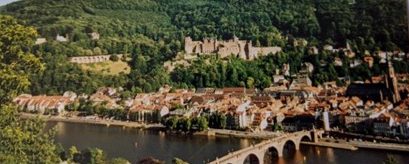
The day of reckoning came with the mandate that we all needed cars for transporting to classes all over Germany. The U.S. military self-serve used car lot near Patrick Henry Village was the place to find our bargain vehicles. These used “car lots” were typical in the military overseas as military personnel sold their “junkers” when leaving to incoming personnel who bought them for their temporary transportation needs while stationed there. We had little time to make decisions. I chose a 1980 four door Mercedes with a manual transmission and a diesel engine. It had good winter tires and fit my budget. I failed to ask how fast it could go on the Autobahn. A big mistake. I learned later that it could go only 115K (about 71 mph) at top speed. Which required that I quickly compensate for that on the road! Fortunately, I had much experience as a driver to make this work.
I now owned a Mercedes! The manual choke was fiddly and troublesome until I had it repaired. I called it my Panzer. It was a “tank”. Sadly, the hood ornament was missing. One essential addition was to buy a new star hood ornament at the local Mercedes dealership. It made all the difference to my driving to see that hood ornament. I had arrived.
New faculty disbanded from the UMUC headquarters by packing our cars with our two suitcases, new text books for our courses and maps that showed us our destination. Most of us learned to keep a box in our trunk that we called our office. The box contained our teaching materials and was refreshed with new materials as needed each term. Some of us formed a small convoy as we headed in similar directions. The world expanded rapidly once I entered the Autobahn – without a GPS – only with a memorized set of off-ramps called Ausfahrts.
My first eight-week lodging was a rented room with one of the field reps in Grosauheim. Her husband was on Temporary Duty (TDY) in Turkey. The room came with kitchen privileges and unlimited red current snacks from the abundant bushes in the garden. My lodging included an excitable Doberman Pincher who gave the occasional growl outside my door at night. I got used to it. It worked.
Two of my classes were nearby. It was an easy commute to these infantry army posts. Students arrived in uniform and seemed tired and weary from work and stressful physical work including early morning PT – physical training. It was a no frills environment. Huge trucks and other equipment military equipment surrounded the buildings.
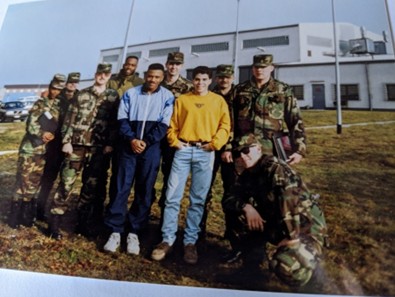
One of my teaching sites along the Main River bordered on an ominous steaming nuclear power plant – a shock to my eyes from a distance. However, as I approached it revealed a pastoral setting of a shepherd with hundreds of sheep grazing around the nuclear plant. A marvelous dichotomy between old and new.
My teaching routine was to complete the morning class and prepare for the next session. Then, eat and prepare for evening classes. Lunch beckoned. Oddly, German eating-places closed for lunch. It was their “Mittagspause”. As an entrepreneur, it made no sense to me. Adjusting to the culture included bringing prepared food. It was one of many flexible changes needed in my time in other countries.
Twice a week I drove to an evening class in Wuerzburg about 100 K or 60 miles away. I would drive on the # 3 Autobahn, a main arterial going east and west. It was a visible supply chain of trucks full of merchandise coming and going to Western and Eastern Europe. During the daylight hours, I delighted in seeing license plates from Poland, Hungary, Rumania as well as Germany, Belgium, France etc. I also saw long convoys of large U.S. military trucks a very visible sign of their large presence in Germany.
The divided two- lane highway meandered through a mountain range. Long lines of trucks heaved over hills. It was hard to pass them. A problem. With dismay, I now discovered that my car maxed out at 115K – 71mph. This meant I could not drive in the fast lane where passenger cars were going 140 – 160 K or 80 to 90 mph. With great care, I timed my driving to get out behind the trucks and pass three to four trucks at a time. My car and adrenalin were in high gear each time. Little did I anticipate being saved by a truck driver – who I would never know – one dark night when driving back from my class in Wuerzburg.
One evening in Wuerzburg, after a full day of teaching, after my students left and the lights were out; I dutifully returned the classroom keys to the MP station on post. It was almost 10 p.m. and the drive back to my rented room would take over an hour. Long lines of red lights greeted me as I entered the #3 Autobahn going west. I settled into the convoy of trucks in the slow lane as usual ready to pass when possible.
As always, I cautiously I looked into the rear- view mirror and over my left shoulder and mirror. It was dark – no lights along the road. If the right lane was free of oncoming car headlights, I would merge into the fast lane and drive as fast as I my car would allow to pass as many trucks as possible. Then, I quickly got back into the slow lane of a long line of the heaving truck convoy winding through the curvy mountain road.
It worked many times. However, one night, a deadly almost fateful incident miraculously saved my live by an unknown trucker. It was a dark night of long lines of truck – I only saw red brake lights while tucked between long lines of large trucks. As always, I cautiously pulled into the fast lane as I saw a clear opportunity to pass a few trucks. Woe! The truck behind me blinked his lights erratically and followed me into the fast lane. What? That was odd! Danger! Now partially in the fast lane I glanced to my left again. A scary sight approached like a speeding bullet and came barreling down the fast lane toward me. In an instant, I knew the truck behind me was saving me. I immediately I pulled back into the slow lane. The truck behind me followed me back to the slow lane as the car on my right sped past! The trucker behind me saved my life. My gratitude stays with me for the goodness of the stranger who saved my life. I would never know who it was. He had been a buffer for the speeding car in the fast lane and would have taken the brutal hit to save me. Suddenly I felt immensely grateful for the good people I would never know- who care to protect and shelter others. It was a miracle to me, and it is lasting thankful memory.
My next assignment was in the greater Frankfurt area- to include Bonn that was then still the capital city of Germany even when reunified. My assignments for the next three terms required daily travel ranging from Frankfurt to Mainz, Aschaffenburg, Giessen and Bonn. However, I was at home in a comfort zone living and socializing with cousins in the village – Liederbach of my childhood 8 kilometers from Frankfurt. It was a sweet time of acceptance to walk the village streets and surrounding fields I had known so well for the first eleven years of my life. It provided a sense of closure to childhood memories by visiting the graves of my father – killed during WWII, uncles who met the same fate, loving grandparents who had cared for me, cousins and childhood friends who perished in automobile accidents.
Rhein/Main Airbase where I taught many classes in the years to come had a special place in my heart. My older brother at 17 had helped build the airstrip that would facilitate the airlift “Luftbruecke” in 1949 to carry supplies to Berlin. My brother had worked as a day laborer on Rhein Main Airbase earning real money to share with our family. It was a fortune in hard currency to us. I was six years old when my brother used part of his paycheck to purchase a dress for me for my initiation to the first grade. It was my first new dress not made from left over scraps. It was a wonderful gift. A memory I cherish to this day. I wore it proudly on my first day to school.
Years later, in honor of his generosity, I would sit at the runway at Rhein/Main Airbase and celebrate the past. The runway eventually become part of the Frankfurt Airport. The Airbase closed years later.
